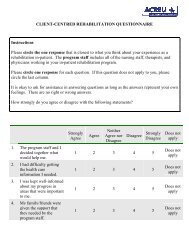Client-Centred Rehabilitation - Arthritis Community Research ...
Client-Centred Rehabilitation - Arthritis Community Research ...
Client-Centred Rehabilitation - Arthritis Community Research ...
Create successful ePaper yourself
Turn your PDF publications into a flip-book with our unique Google optimized e-Paper software.
likert-type scale) 16 barriers to clientcentred<br />
practice identified from the literature<br />
with respect to how much each barrier<br />
prevented client-centred practice. In<br />
addition, therapists indicated how much<br />
each of 18 methods selected from the<br />
literature would assist in resolving these<br />
barriers. The three highest ranked barriers<br />
were: 1) the therapist and client have<br />
different goals; 2) the therapist=s values and<br />
beliefs prevent them from accepting the<br />
client=s goals; 3) the therapist is<br />
uncomfortable letting the client choose<br />
his/her own goals. The three highest ranked<br />
methods for resolving therapist barriers<br />
were: 1) case examples showing how to<br />
practice in a client-centred fashion; 2)<br />
management and peer support for use of<br />
client-centred practice; 3) involvement of all<br />
staff in client-centred practice training.<br />
Barriers as ranked in this study were<br />
primarily related to incongruence between<br />
therapist and client goals and values, with a<br />
smaller emphasis upon environmental and<br />
cultural barriers. Barrier resolution focused<br />
primarily upon educational strategies.<br />
2.3.2 Medical Literature: Patient-<br />
<strong>Centred</strong> Care<br />
There was an extensive literature that<br />
discusses patient-centred care in the general<br />
practice setting. This literature tended to<br />
focus on issues around physician-patient<br />
communication. <strong>Research</strong> on patient-centred<br />
care has been conducted since the late<br />
sixties. Provided below is a discussion of the<br />
components within patient-centred care that<br />
have received attention within the general<br />
practice literature.<br />
2.3.2.1 Definition of Patient-<strong>Centred</strong><br />
Care<br />
There is much disagreement as to what<br />
patient-centred care really means (Mead and<br />
12<br />
Bower, 2000). Epstein (1997) described<br />
many different models of patient-physician<br />
relationships, two of which embody patientcentred<br />
care: 1) the patient-centred model<br />
which focuses on both physicians and<br />
patients sharing power and understanding<br />
the medical condition and 2) the deliberative<br />
model which stresses the physician<br />
involving the patient in discussions and<br />
providing treatment options. Chewning and<br />
Sleath (1996) argue that the patient-centred<br />
model consists of the patient and provider<br />
collaborating in identifying treatment goals,<br />
choosing from regimen options, monitoring<br />
symptoms and evaluating and revising<br />
regimens. Weston and Brown (1995)<br />
provided a detailed model of patient-centred<br />
care which consists of six aspects: exploring<br />
the disease as well as the experience, seeing<br />
the patient as a person and being aware of<br />
his/her history and current situation,<br />
negotiation of goals, problems, priorities and<br />
roles of doctor and patient, and striving for<br />
health prevention and promotion.<br />
2.3.2.2 Patient-Doctor Collaboration<br />
Much of this literature has stressed that<br />
doctors need to listen to their patients and<br />
see them as individuals (Speechley, 1992;<br />
Krupat, Hiam, Fleming and Freeman, 1999;<br />
Rothstein, 1999). A study by Carroll,<br />
Sullivan and Colledge (1998) found that<br />
patients perceive physicians listening to<br />
them as the most crucial aspect of general<br />
practice.<br />
Doctors also need to encourage the sharing<br />
of information, power and control with their<br />
patients (Krupat, Hiam, Fleming and<br />
Freeman, 1999). General practitioners not<br />
only have an obligation to provide<br />
information at the beginning of treatment,<br />
but throughout the therapy/treatment when<br />
the number of patient’s questions is<br />
numerous (Speechley, 1992). Laine and








